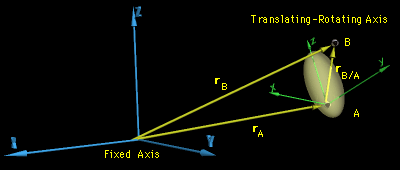| Ch 9. 3-D Motion of a Rigid Body | Multimedia Engineering Dynamics | ||||||
| Translating Coordinates | Rotating Coordinates | Inertia & Ang. Momentum |
Equations of Motion |
||||
| 3-D Motion: Rotating Coordinates | Case Intro | Theory | Case Solution |
| Chapter |
| - Particle - |
| 1. General Motion |
| 2. Force & Accel. |
| 3. Energy |
| 4. Momentum |
| - Rigid Body - |
| 5. General Motion |
| 6. Force & Accel. |
| 7. Energy |
| 8. Momentum |
| 9. 3-D Motion |
| 10. Vibrations |
| Appendix |
| Basic Math |
| Units |
| Basic Dynamics Eqs |
| Sections |
| eBooks |
| Dynamics |
| Fluids |
| Math |
| Mechanics |
| Statics |
| Thermodynamics |
| ©Kurt Gramoll |
|
|
|||||
| Rotating 3D Coordinate System |
|||||
|
|
Previously, general motion for a translating 3-D coordinate system xyz was examined. The most general way to analyze 3-D motion requires the use of a coordinate system xyz that both translates and rotates relative to a fixed system XYZ. This method is useful for determining the motions of two points on separate parts of a mechanism, or for determining the relative motion of two or more particles when one or both are moving. As illustrated in the animation, consider a rigid body that is translating and rotating relative to the fixed reference frame XYZ with an angular velocity Ω and an angular acceleration dΩ/dt. The position vectors, rA and rB specify, relative to XYZ, the location of point A, which is fixed to the rigid body, and point B, which is NOT fixed to the rigid body and thus may move relative to A. The origin of the xyz coordinate system is located at A, and translates and rotates with the rigid body. The position of B with respect to A is given by the relative position vector rB/A. |
||||
 Position Vector Diagram |
|||||
| Position |
|||||
|
Using the equation of relative position, point B can be related to point A as Here, rB/A = xi + yj + zk since A is set to the origin of the local coordinate system, xyz. |
|||||
| Velocity |
|||||
|
The velocity of B measured from XYZ can be determined by taking the time derivative of the previous position equation gives, rB/A can be evaluated by applying the equation for determining the derivative of a vector measured from a fixed to a translating-rotating system (see previous section, 3D Translating Coordinates), By substituting, we get Here, (vB/A)xyz or (vB/A)rel is the relative velocity of B with respect to A as measured from xyz. |
|||||
| Acceleration |
|||||
|
The acceleration of B measured from XYZ can be determined by taking the time derivative of the previous velocity equation to give, We have already determined that By substituting, we get
Not surprising, but it is interesting to note that the velocity and acceleration equations for 3D rotating reference coordinate system are the same as for 2D equations when written in vector form. However, the dΩ/dt term is tricky since does not have a constant direction like in 2D motion, and must be determined from (see previous section), dA/dt = (dA/dt)xyz + (Ω × A) |
|||||
Practice Homework and Test problems now available in the 'Eng Dynamics' mobile app
Includes over 400 free problems with complete detailed solutions.
Available at the Google Play Store and Apple App Store.



